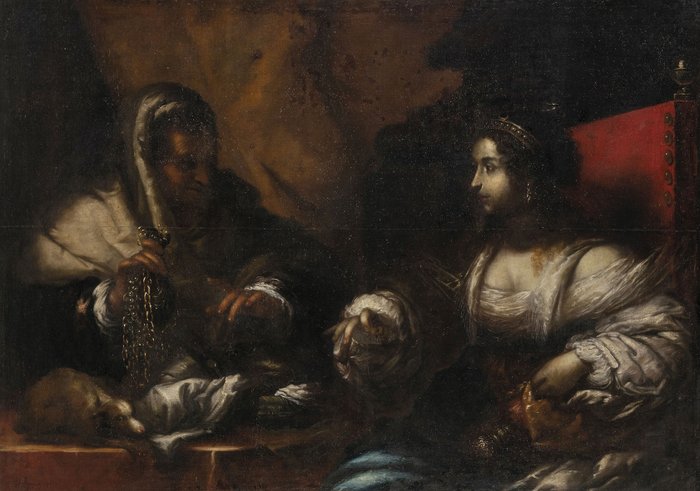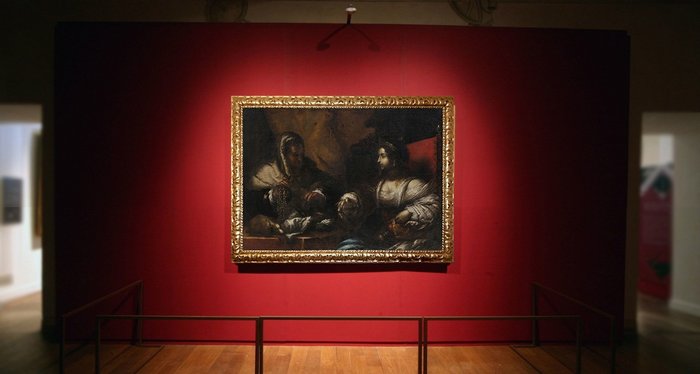Advert Description
Are you interested in this item? This item is up for auction at Catawiki. Please click on "respond to advert" (orange button) to get redirected to the Catawiki website. Catawiki’s goal is to make special objects universally available. Our weekly auctions feature thousands of unusual, rare, and exceptional objects you won’t find in just any store. FRANCESCO MONTELATICI, known as CECCO BRAVO
(Florence, 1601 – Innsbruck, 1661)
Temptation scene
Oil on canvas, cm. 116x166
expertise Sandro Bellesi
NOTES: Publication of the catalog of works from the Intermidiart collection. Expertise Sandro Bellesi. Certificate of Guarantee and Lawful Origin. Artwork with golden frame:
This interesting painting was traced back to the catalog of Francesco Montelatici known as Cecco Bravo (Florence, 1601 - Innsbruck, 1661), by the well-known historian Sandro Bellesi with a card written to the owners:
“ … Selected on strongly burnished tones, the canvas, in good condition, shows a scene full of fascination due to the enigmatic formulation of the illustrated episode, whose iconographic or iconological interpretation is still a mystery due to the lack of appropriate letter keys, unfortunately lost with the passage of time. Currently known to art critics in two other editions which we will return to later on, the work shows in the foreground, within an undefined environment dominated by a large curtain, two female figures near a table. A young and attractive woman, probably a queen due to the presence of a crown in her hair, is positioned on an elegant chair with a high back and an old woman appears in front of her, whose face is mostly mentioned in the shadow, portrayed in the act of holding a leather pouch and numerous necklaces of gold or other precious metals in her right hand. Certainly linked to a moral message not without Christian eschatological meanings, the work probably alludes to a scene of temptation connected to earthly goods, symbolized, as ephemeral values of human existence, by greed and the power of wealth in the earthly world. The presence of a small dog, curled up and almost frightened, placed next to the bag and the necklaces, probably alludes to the only terrain to which the two women show loyalty: wealth. In fact, the dog is by popular and iconographic tradition a symbol of fidelity, fidelity connected, in this case, only to earthly material goods.
Based on the comparison with two other pictorial examples known today depicting the same composition and the stylistic and executive characteristics, the work can be assigned to the catalog of Francesco Montelatici, better known as Cecco Bravo, one of the most original and extrovert painters active in Florence at the mid-seventeenth century.
Born in the city of Giglio in 1604, the artist, initially educated in the study of painting in the school of Giovanni Bilivert and then under the guidance of Sigismondo Coccapani, began to work from the early 1920s, the time in which his presence is documented in some Medici enterprises assigned to Matteo Rosselli. In the environment of this esteemed master, Montelatici was able to approach the whimsy and eccentricities of Domenico Pugliano and Giovanni da San Giovanni, artists with whom he highlighted, especially in the more advanced phase of his activity, significant points of contact. After probable study trips to Emilia and Venice, the painter gave way, in Florence, to a tight independent activity characterized by a significant number of works, essentially based on a free stylistic language, devoid of fixed rules, where the figures mostly defined in a bizarre way and with a strong empathic charge. Attentive to the pictorial experiments of his time, the artist, who achieved a place of honor at the Accademia del Disegno in 1638, approached the sensual poetics of the Furinian matrix during the forties and subsequently manifested direct contacts with the anti-academic tendencies of a Venetian imprint, common to artists such as Strozzi and Mazzoni, the latter a painter often confused with ours. After years of good artistic recognition in Tuscany, the artist was summoned in 1660 to the court of Innsbruck, where he died the following year (for the artist see above all Cecco Bravo. Florence 1601-Innsbruck 1661. Painter without rule, catalog of the exhibition curated by A. Barsanti and R. Contini, Milan, Florence, 1999 and, more recently, S. Bellesi, Catalog of Florentine painters of the 1600s and 1700s.Biographies and works, Florence, 2009, I, pp. 203-205 and III, Figs 1090-1106).
As already indicated, the work in question is to be placed in close relation to two other autograph paintings by the same artist, known for some time to art critics. These are two canvases conserved, respectively, at Mina Gregori in Florence and in a private collection (for these see separately A. Barsanti in Cecco Bravo. Florence 1601-Innsbruck 1661. Painter without rule, exhibition catalog edited by A. Barsanti and R. Contini, Florence, Milan, 1999, p. 33, as a private collection and F. Baldassari, Seventeenth-century painting in Florence. Index of Artists and Their Works, Turin, 2009, p. 571, fig. 330). Compared to these, our sample differs in any case for a drier and more compact painting, certainly attributable to a different execution time. Characters analogous to our painting actually recur in the painter's early production, as can be seen from the lexical comparison with paintings by him such as the pair of small pictures with Esau and Jacob and Judith with the head of Holofernes and the maid Abra in the Rosselli del Turco collection in Florence, Santa Chiara who rejected the attack of the Saracens in Assisi in a private collection or, again, San Giorgio with the dragon formerly at Sergio Scatizzi in Florence (for these works see Cecco Bravo, op. cit., 1999, pp. 58-59 nos. 7-8, 68-69 no. 13): datable to the twenties and thirties of the seventeenth century.
The choice of a mysterious iconographic theme imbued with strong ethical and moral values brings the painting closer to the elitist world of the most sophisticated Florentine culture linked to the "academies", i.e. exclusive private circles, within which topics of study of various types connected to science, philosophy, reading and even esotericism. Subjects such as the one treated by Cecco Bravo in this realization are very rare in Italian painting of the time and find appropriate references only in private commissions, about which we know very little today, as evidenced, for example, among the best known specimens, by one of the pictorial compositions of Cesare Dandini most appreciated, or the Young woman with sorceress, known at the moment in various autograph editions of the artist or pertaining to his workshop (in this regard see S. Bellesi in Luce e Ombra. Caravaggism and naturalism in Tuscan painting of the seventeenth century, exhibition catalog edited by P. Carofano, Pontedera, Pisa, 2005, pp. 42-45 n. 14; with previous bibliography).
With regard to its state of conservation, the work is presented with an antique lined canvas with a recovered canvas showing a lack of fabric in the upper left quadrant allowing the original canvas to be seen without jeopardizing its conservation. The pictorial film is very dirty, with the paint oxidized and no longer uniform and with some remakes. You can see – in Wood's light – a thick varnish and small retouches scattered in the background. The measurements of the canvas are cm. 116 x 166. The painting is embellished by the well-made gilded wooden frame. "The frame shown in the photos above has been added to the artwork by the seller or a third party. The frame is provided to you at no additional cost so it is ready to display as soon as it arrives. The frame is included as a gift courtesy and is not considered an integral part of the artwork.Therefore, any potential damage to the frame that does not affect the artwork itself will not be accepted as a valid reason to open a claim or request cancellation of the order ."
Provenance: Coll. Sicilian private
Publication:
? Unreleased;
? The Myths and the Territory in Sicily with a thousand cultures. UNEDITED QUADRERIA general catalog of paintings from the collection of the cycle "Myths and the territory", Editore Lab_04, Marsala, 2022/2023.
We also guarantee careful packaging with an external wooden crate and internal bubble wrap / cardboard / polystyrene (packaging cost approximately € 250.00) and tracked shipping (€ 300.00 Italy). For export, the work is subject to a request for a Certificate of Free Circulation (European Community) or a Certificate of Export (Extra Community Transport), at the export office (Superintendency of the territory) with the times and costs burdened ( €450/€1,500, all inclusive: shipping, packing and some exports).
The shipment could be delayed by a few days/weeks for logistical and administrative reasons. 67453699





